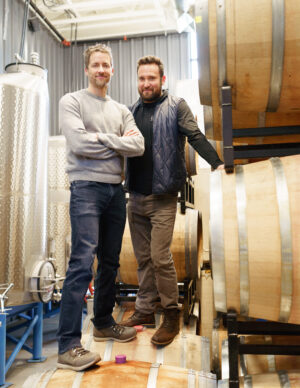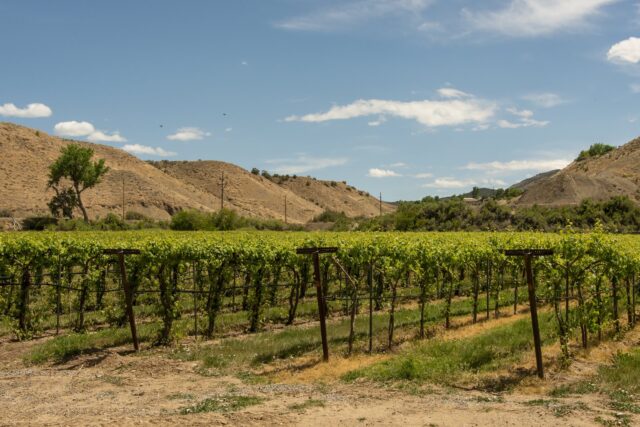The Mile High State leans into hybrid varieties in response to extreme climate challenges.
By Kathleen Willcox
Colorado has been producing locally grown and bottled wine since 1890, but it’s just now reaching that adolescent stage of development, in which it establishes who, precisely, it is — and how it relates to the rest of the world.
Unlike other regions, where one grape dominates the conversation (Pinot Noir in the Willamette Valley or Riesling in the Finger Lakes, for example), there are several grape varieties vying for attention. Increasingly, cold hardy hybrid grapes are coming into focus as both the climate and the reception for these grapes change.
Climate Demands Change
For decades in Colorado, producers focused exclusively on vitis vinifera. But following several years of extreme freezes in the spring and fall, that focus has shifted for many. In October 2020, a frost wiped out almost all of the vitis vinifera in the state, prompting Governor Jared Polis and Colorado Commissioner of Agriculture Kate Greensberg to declare a federal disaster in much of the affected areas. That declaration let growers apply for emergency funding to cover their losses, but it hardly provided a roadmap for the future.
![[iStock]](https://wineindustryadvisor.com/wp-content/uploads/2022/06/istockphoto-1296501653-612x612-1-300x200.jpg)
“Colorado’s wine country has a very unique terroir,” says Jenne Baldwin-Eaton, winemaker-turned-program lead of the viticulture and enology program at Colorado Mesa University in Grand Junction, Colo. “While most wineries initially only wanted to work with vitis vinifera, back-to-back devastating freezes changed things. If they chose to work with Colorado grapes in certain years, they had to be cold hardy cultivars, because they’re the only grapes that survived the sudden freezes.”
The grape-growing region, at first glance, seems extraordinary for vitis vinifera. Colorado has some of the highest elevation vineyards in the world, ranging up to 7,000 feet above sea level. (Only Argentina has Colorado beat in terms of elevation). There are more than 300 days of sunshine every year. Two AVAs produce 90 percent of the grapes grown there: the 76,000-acre Grand Valley, which hugs the Colorado River between Palisade and Grand Junction; and the 48,000-acre West Elks, along the North Fork of the Gunnison River between Paonia and Hotchkiss. The soils are alkaline, the climate is dry and disease pressure is low.
Commercial winegrowing began in earnest when Warren Winiarski was lured over from Robert Mondavi Winery to Denver’s Ivancie Cellars in 1968. Still, the growth was initially slow. In 1990, there were just five wineries in the state. That rate of growth has increased significantly: now there are 170, and the average annual rate of growth is 10 percent — much higher than the industry average, according to the Colorado Wine Industry Development Board.
The New Normal
These days, the challenge for Colorado is the extremes, including triple digit heat in the summer, bookended by screaming cold snaps in the fall and spring.

“The prolonged warmth is what makes those extreme frosts such a problem,” says Kevin Webber, CEO of Carboy Winery (Littleton, Colo.), which has 30 acres under vine and works with three growers to produce around 25,000 cases annually. “In October 2020, it was 80 degrees, and then it suddenly plunged to 31, which caught the vines off-guard, killed the grapes and, in many cases, split the vines too. Then in April 2021, we got hit with frost right after bud break.”
Webb and his team used the disaster as an opportunity for “R&D of hybrids,” he says. “We experimented with different harvest times, yeasts, fermentation and aging techniques on all kinds of cold hardy grapes.”
Evolving Winemaking Practices
But here’s the thing: Cold hardy grapes were developed at the University of Minnesota and Cornell University for consistently colder climates. They were primarily intended for use in Vermont, Upstate New York, Michigan and Canada, none of which have the prolonged hot and dry growing season of Colorado’s high desert. This is, many say, both an opportunity and a challenge.
“I grew up in Missouri, where we use a lot of French American hybrids, so I was open to hybrids before a lot of other producers here were,” says Garrett Carlson, winemaker and co-owner of Carlson Vineyards (Palisade, Colo.). “We produce about 14,000 cases per year, and about half of that comes from hybrid grapes. They can take the heat of the summer and withstand the cold, which makes them reliable here. One of my favorite ways to use them is in blends, because vinifera loses acid in the extreme heat of the summer. I love our Riesling-Gewürtraminer blend with Vidal Blanc. That Vidal Blanc provides the bright acidic backbone the wine needs.”
Baldwin-Easton has been toiling away with students and winemakers on small-scale research projects at Colorado Mesa.
“We have to figure out how the salty, high pH soil and triple digits in the summer affect different cold hardy grapes,” she says. “We’re experimenting with how prolonged or shortened skin contact, cold fermentations, carbonic macerations and other techniques affect the flavor, texture and aroma of grapes.”
While Baldwin-Easton doesn’t see Colorado vintners pulling out all of the vinifera for hybrids, she predicts that they will become an increasingly important component in single varietal expressions and blends with vinifera in the coming years.

Like Webber and Baldwin-Easton, Patric Matysiewski, winemaker at Sauvage Spectrum (Palisade, Colo.), has been knee-deep in experiments on hybrids in recent years.
“It’s been a tough learning curve,” Matysiewski admits. “We had a breakthrough in 2019 after I learned about natural winemaking techniques in the South of France, and we decided to try what they were doing there here.
“With reds, I’ve had quite a bit of success going carbonic on certain varieties and then even blending them back with other varieties treated as standard open red ferments. White skin contact can also produce beautifully weird but great wines.”
Promising Varieties
There are several varieties currently generating excitement in Colorado.
“We’re most excited by Traminette, which is a cross between Gewürtraminer and Joannes Seyve,” Webber says. “It can withstand the extreme frost and heat, and it actually becomes extraordinarily aromatic from the heat here. La Crescent and Vignolles make fantastic sparkling wine, and Petite Pearl and Frontenac are great in rosé. For reds, we’re putting in Marquette and Chambourcin.”
Webber and others are now investing in hybrids. Of their 30 acres under vine, about half is devoted to eight different hybrids. He sees it as the future, and not just because of climate change.

“There’s a changing of the guard happening among consumers right now,” Webber notes. “Millennials and other younger consumers don’t demand Cabernet Sauvignon like their parents did. They also want eco-friendly wine, and they’re open to different styles and varieties. Growing Cabernet here is expensive and requires inputs that cold hardy grapes don’t.”
Overall, about 19 percent of Colorado’s wine grape acreage is devoted to non-vinifera grapes, much higher than the global average of less than 5 percent.
“Long term, Colorado should plan on hanging its hat on terroir-driven hybrids,” says Carlson. “We are in a weird spot, as far as climate — a little too harsh for vitis vinifera, but warmer than hybrids are used to — but that warmth brings out new ripeness levels in hybrids, the kind they’d never see in Missouri. And the acid is still there. Those cold hardy grapes develop flavor and complexity that lets them stand toe-to-toe with vitis vinifera in a way that I haven’t seen in other places.”
No major wine-growing region has been able to use hybrids as a route to the world stage. And while the vast majority of Colorado wine sales are DTC, the wines are popping up in select restaurants and shops outside of the state. Most producers would like to see that trend continue. Time, terroir and climate change will tell.
_______________________________________________________

Kathleen Willcox
Kathleen Willcox writes about wine, food and culture from her home in Saratoga Springs, N.Y. She is keenly interested in sustainability issues, and the business of making ethical drinks and food. Her work appears regularly in Wine Searcher, Wine Enthusiast, Liquor.com and many other publications. Kathleen also co-authored a book called Hudson Valley Wine: A History of Taste & Terroir, which was published in 2017. Follow her wine explorations on Instagram at @kathleenwillcox




